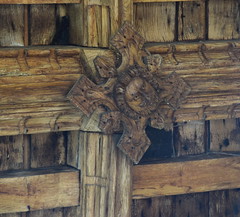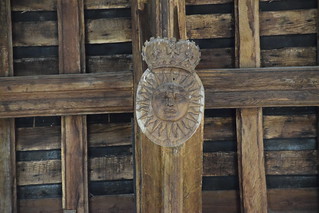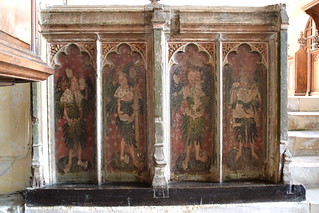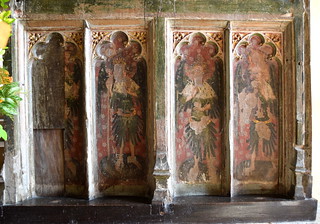| |
|
If you don't know
mid-Suffolk, you may well be surprised by the
hills which roll across the space between
Stowmarket and Hadleigh, as if this was not East
Anglia at all. In this remotest part of the
county, miles from the nearest town, villages
take on a self-sufficient air, and Hitcham is the
largest of them. Its church, All Saints, sits
high in a wide open churchyard on the outskirts
of the village. The house opposite the entrance
to the graveyard was the medieval guild hall.
This is a big church, and was once the centre of
one of the county's largest parishes. It was the
Priory of Ely's most valuable living in the whole
of the county, worth twice as much as any other,
and was therefore bestowed on favoured clerics.
This situation continued when the patronage was
taken over by the state after the Reformation,
and to be made rector of Hitcham remained a
desirable appointment well into the 20th Century.
As the excellent guidebook notes, some rectors of
this parish achieved fame and influence. Take
Adam Easton, for instance. In the 14th Century,
he was made a cardinal while still rector here.
However, as he was also Archdeacon of Shetland,
Orkney and Dorset, as well as Prior of Saint
Agnes at Ferrara in Italy and the personal
secretary to Pope Urban VI, one assumes that he
didn't spend a lot of his time on parish
business. His successor John Bremore was the
personal secretary to the antipope John XXIII at
Avignon, so presumably he didn't live in the
parish either.
John Whytewell, Rector throughout the
Reformation, was chaplain to Thomas Cranmer,
although, unlike that stubborn character, he
received a royal pardon from Mary. Coming forward
to the 17th Century, Laurence Bretton was a solid
Laudian, ensuring his inevitable removal by the
Puritans as a scandalous minister (for which,
read 'liberal intellectual'). His successor,
Miles Burket, had also been a Laudian, but in a
Vicar of Bray fashion he became the Puritan
preacher here, and died in poverty after the
Restoration.
Mostly, the Rectors here seem to have been a
jolly lot. John Matters, in the first decades of
the 19th century, was famous for his befriending
of, and care for, the poor of the parish, matched
only by his neglect of his ecclesiastical duty.
He is quoted in the guide as having a favourite
saying: He that drinks strong beer, and goes
to bed quite mellow, lives as he ought, and dies
a hearty fellow. And his successor was
Hitcham's most famous rector of all, but we'll
come back to him in a minute.
Hitcham was not home to a great landed family, so
it was the power and wealth of Ely priory that
built this church. It is a grand affair, entirely
rebuilt in the 14th and 15th centuries. One look
tells you that this was not a piecemeal building.
Mortlock observes that the grand flushwork porch
is very like the one at neighbouring Bildeston,
but it does not seem so imposing here against
this big building. There is a very odd stop on
the 15th century doorway. The one on the left is
a lion, but on the right there appears to be a
wild man and a tree surrounded by a picket fence.
At first sight, the interior is slightly
disappointing. Large and plain, it is as if it
had been scraped clean by Miles Burket's cronies,
perhaps in reaction to the incumbency of Laurence
Bretton. The brick floors are attractive, and the
fine 14th century aches of the arcades reach
right up into the clerestory, but the heavy
Victorian woodwork gives it all a sombre feel.
The hammerbeam roof was rebuilt after the
Reformation, and includes lots of unfamiliar
secular imagery, the heraldry of the State.
However, there is some dispute about exactly when
this happened, why, and how much was renewed. The
arms of both James I and Charles I are here,
giving a date in the first third of the 17th
century, but the pineapple pendants appear more
recent. At the west end, however, there are a
couple of secretive green men on the hammer beam
ends, which must be from an earlier age. One
theory suggests that the roof was repaired in a
hurry after a fire, and then beautified later.  
The chancel is a
19th century rebuilding (a photograph of this
event, which used to be at the west end, is
rather alarming, like a gap-toothed Madonna) and
it is evidence of the Anglo-catholic enthusiasm
of Alexander Grant, Rector for the last 40 years
of the 19th Century. At nearby Kettlebaston, this
enthusiasm was realised by the Vicar there in the
form of a gorgeous little shrine, but here,
something more grandiloquent was intended. Hence
the five steps up to the chancel, and two more up
to the sanctuary, representative of the seven
sacraments of the Catholic Church, and familiar
from 19th century London Anglo-catholic churches.
There is no evidence that Anglo-catholicism ever
took such a firm foothold here, though.
The chancel is so grand, some visitors must
easily overlook the remains of the rood screen.
Only the dado survives, but it is worth a look
because instead of saints the panels depict
angels holding the instruments of the Passion.
Something similar can be seen at Blundeston in
the north of the county, and there are also
angels on the screen at Southwold of course. Not
surprisingly, they were vandalised by the 16th
century reformers. What is more surprising is
that they have survived at all. Presumably they
were moved to their present position at the time
of the 19th century reordering, but when Arthur
Mee came here in the 1930s, he could barely
discern them as figures, and thought them saints.
So they've been restored, probably under the
influence of Munro Cautley when he was diocesan
architect.
 
In such a wealthy
parish, perhaps it is not surprising that little
else medieval survives. The converse of this, of
course, that the restoration of this church has
generally provided work of quality. Although the
benches are heavy, they do carry several bench
ends which are probably the work of the great
Ipswich woodcarver Henry Ringham. The best are
the four evangelistic symbols towards the front.
In fact, the guidebook suggests that the benches
were removed from the church towards the end of
the 19th century and replaced with chairs as at
Rattlesden and Kettlebaston, only to be returned
at the behest of the eccentric and
splendidly-named Maxwell Maxwell-Gumbleton, who
was jointly Bishop of Dunwich and Rector of
Hitcham in the 1930s and 1940s. Maxwell-Gumbleton
had a Bishop's throne built, which he installed
in the chancel. It must have given his
parishioners something to think about. It is
still there today, and is replicated in slightly
more modest form by the churchwardens' seats at
the west end. Maxwell-Gumbleton's also are the
George VI coat of arms, dated 1937, and a lovely
modern font cover, given as a memorial.
From an earlier age are the very elaborate brass
inlay in front of the sanctuary, and the mid-17th
century memorial to a Waldegrave in the north
aisle, more austere than it would have been
twenty years before or after. In the south aisle
there is a copy of the Adoration of the Magi
by Rubens, which is in Kings College Chapel. At
first, I couldn't work out why it looks a little
odd, and then it hit me - it is in reverse.
Many years ago, I chatted with a churchwarden
here, and she told me that although 42 men in
this parish lost their lives in the first world
war, only 28 of them are remembered on the war
memorial here. She suggested that this was
perhaps because the others were from chapel
families, or perhaps the families had moved away
before the memorial was installed. Whatever, it
gave me pause for thought, for if a similar
situation exists in other parishes, then we may
assume that many hundreds of people who gave
their lives have, in fact, been forgotten.
But one name stands out in this parish as forever
being associated with it. You might overlook the
simple memorial in the chancel by Thomas Woolner,
and you'll certainly miss the little memorial
plaque above the door as you came in, but both
are worth a look because they both remember the
same person, the great John Stevens Henslow.
Henslow was a remarkable man by anyone's
standards. He was Regius Professor of Botany at
Cambridge University in the 1830s, and was looked
on with enough favour to secure the lucrative
Hitcham rectorship. However, rather than send a
poorly-paid curate to do his work for him, which
would have been the usual early 19th century
Trollopeian way, he followed in John Manner's
footsteps, and came to Hitcham himself.
It is hard now to imagine what a contrast this
remote place must have been with cosmopolitan
Cambridge, barely 40 miles away. Henslow wrote in
his diary that he had come to "a woefully
neglected parish, where the inhabitants, with
regard to food and clothing and the means of
observing the decencies of life, were far below
the average scale of the peasant class in
England." It is recorded that his first
congregation here in this vast space was
insufficient to fill one pew.
Over the course of the next 25 years, he turned
his parish upside down, applying his scientific
knowledge to the antiquated and conservative
farming methods of the local farmers. He
increased their prosperity, and that of the poor
farm labourers. He started a school, and an
institute of adult education. He led outings
through the local countryside, and would
sometimes take the whole parish on the train to
London, including one trip to the great
Exhibition of 1851 in Hyde Park. It was said that
the entire village emptied on these occasions,
travelling by cart and on foot to Stowmarket
railway station, and then on to London.
"Everyone is to be in good humour", he
told his parishioners, "accommodating to
all, and especially attentive to the ladies of
the party. If the weather should prove
unpropitious, every one is to make the best of
it, and not to complain more than he can possibly
help."
It is said that, on holiday at Felixstowe, he
realised the fertilizing properties of the
coprolite nodules in the cliffs there, and
interested two local farming brothers so much
that they set up a fertiliser processing factory
at Ipswich docks. Their name was Fison.
But an even more famous name associated with
Henslow is Charles Darwin, one of Henslow's
students at Cambridge. Henslow encouraged Darwin
to investigate the development of species,
finding him a place aboard HMS Beagle, the
scientific survey ship. Darwin sent his notes and
samples back to Henslow, who circulated them in
the scientific community. Darwin came back to
England to find himself a celebrity. The basis of
The Origin of Species was put together
at Hitcham Rectory, although Henslow would later
repudiate its conclusions.
Most importantly, however, as far as my children
were concerned when they were younger, Henslow
was the guiding light behind the opening of
Ipswich Museum, which still retains one of the
finest 19th century natural history collections
in the country. A portrait of him hangs in the
entrance hall, and the name of a road in the east
of the town remembers him.
He died at the relatively young age of 65. His
predecessor had been the jolly John Matters. His
successor was the Anglo-catholic enthusiast
Alexander Grant, who, as well as rebuilding the
chancel, is still remembered in the village for
taking the side of the workers during the
lock-out strike of 1874, when he allowed them to
use the church building for their meetings.
These three extraordinary men between them
spanned the entire 19th century here. Trollope
himself could not have written a better novel.
|
|
|

